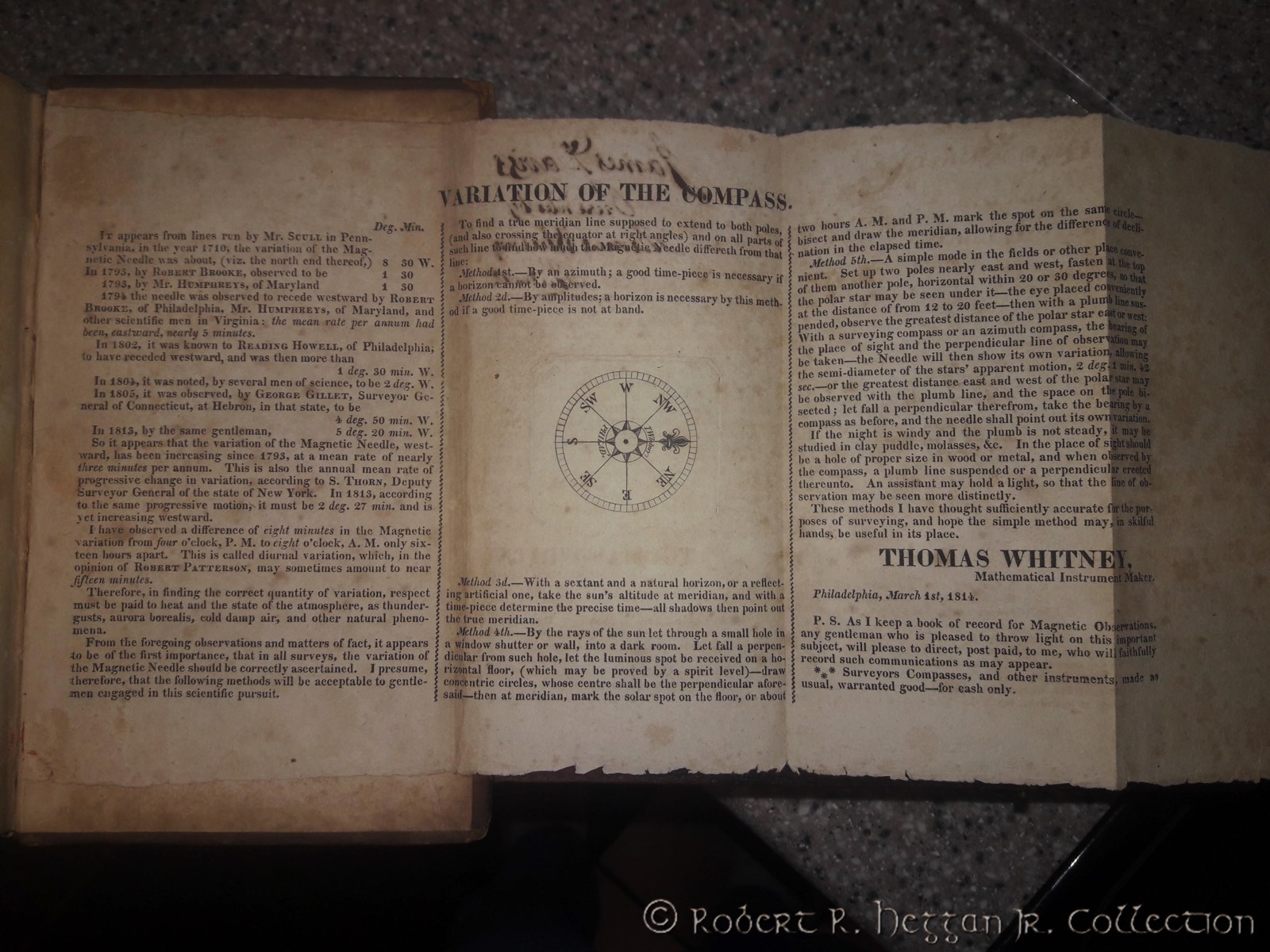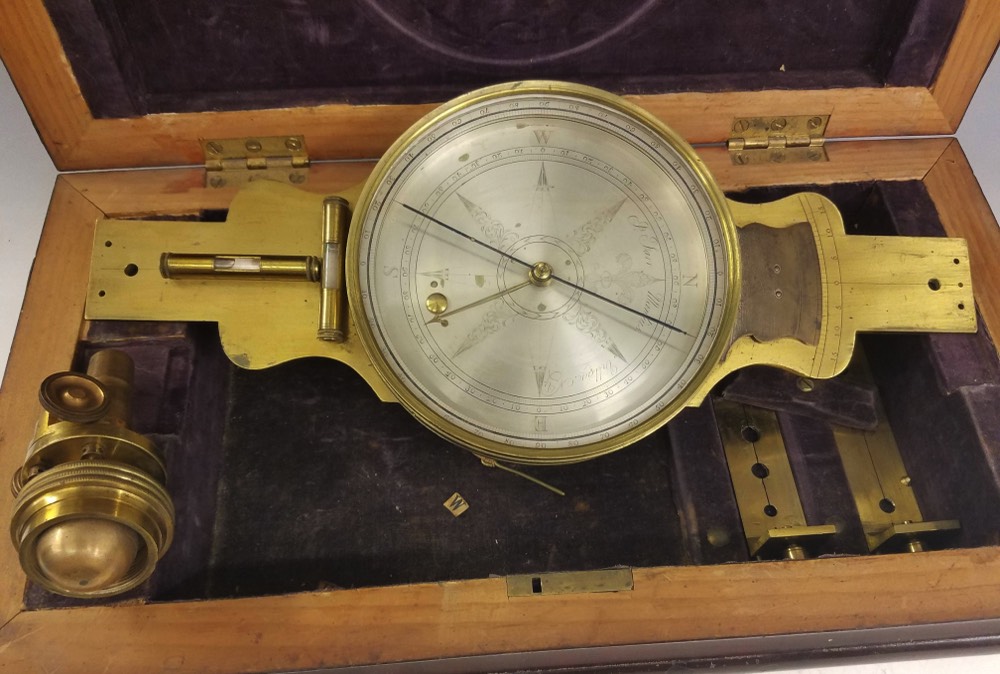
Joseph Farr Presentation Vernier Compass - Circa 1830 - Appears Unused
Colonial And Early American Vernier Compasses
The Magnetic Needle on a Surveyor's Compass points to the Magnetic North Pole. There were two meaningful problems with using a Magnetic Needle to survey boundaries. First, the Magnetic North Pole is in not the same thing as the True North Pole (which is a fixed and knowable location). Second, unlike the True North Pole, the Magnetic North Pole Shifts rather significantly over time (called "Variation" or "Declination"). The Magnetic North Pole also shifts to a much lesser extent daily, and from hour to hour. Think about that for a second. Most of the surveys done prior to 1830 were using a reference point that moved a bit hour to hour and very significantly (degrees) overtime. The Vernier Compass was designed to help surveys deal with the Variation between the True North Pole and the Magnetic North Pole.
If you want to see the shifting of the Magnetic North Pole over time, take a look at National Oceanic and Atmospheric Administration Website. Based on the year and location you pic, this website will tell you how many degrees the Magnetic North Pole varies from the True North Pole.
The Vernier Compass (aka Nonius Compass) was a VERY important instrument in the history of American Surveying. Compared to a Plain Compass, the Vernier Compass made it easier to resurvey old lines, and made it easier to survey using the True North Pole rather than the Magnetic North Pole. A Vernier Compass could also function as a Minute Compass if the Surveyor wanted or needed greater precision.
While there aren't any sales records pre-1850 showing the sales of Plain versus Vernier Compasses, it's clear that Vernier Compasses were big sellers from 1800 on. There are a good number of Whitney compasses known to exist, for example, and more than 50% of the known Whitney compasses made between 1803 and 1823 are Vernier Compasses. That's a pretty good surrogate for the market for Plain Versus Vernier Compasses in my opinion. Vernier Compasses remained popular over time too. In 1857, for example, Gurley sold 110 Vernier Compasses compared to 128 Transits of All Types.
How A Vernier Compass Works
A Vernier/Nonius Compass is the same as a Plain Compass but with ability to rotate the NS axis of the needle ring to relative to the line of sights. Accessories usually include a fine motion means to allow precise setting of angle between NS axis and line of sights and a vernier/nonius to allow accurate measurement of angle between NS axis and line of sights. Maximum angle between NS axis and line of sights was typically limited to ± 8 degrees in 1790 and ± 30 degrees by 1880. There was MUCH more Variation in the Western US than on the East Coast, which required Makers to make compasses that could rotate much more to account for the greater amount of Variation.
If the variation is known the surveyor can rotate needle ring by the proper amount as measured by the scale and vernier and proceed to run his lines. The bearing of each line will be given by the needle reading to the True North Pole.
If the surveyor wants to retrace old lines he locates two adjacent corners of the old survey sets his compass on one of the corners, sets the sights on the other corner and rotates the needle ring until the needle points to the bearing recorded on the old survey.
Important Reference Work - Deborah Warner, "True North - Any Why It Mattered In Eighteenth-Century America"
#1 - Did Surveyors Typically Account for the Difference Between Magnetic North and True North?
Surveyors knew about Variation and the problems with the Magnetic Needle early in the Colonial Era. The Surveyor General of Eastern New Jersey discussed the need to measure the Variation in the needle in great detail in his 1747 Instructions to the Deputy Surveyors.
Notwithstanding knowing about the problems with Magnetic Needle and some mandates requiring them to address Variation, most surveyors apparently ignored the Variation problem in their day to day surveying activities.
According to Deborah Warner (Curator, Physical Sciences Collection, National Museum of American History, Smithsonian Institution) :
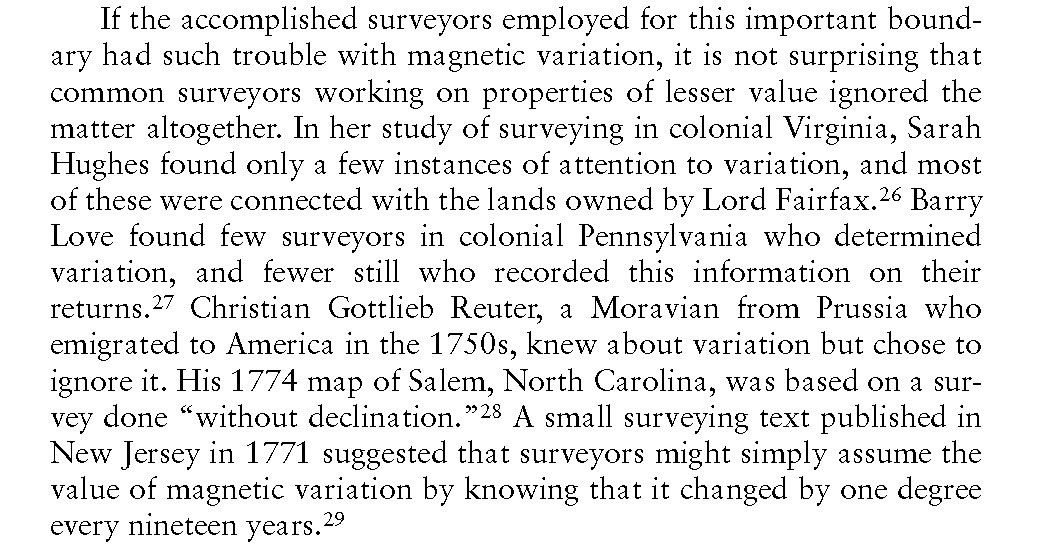
The First American Vernier Compass - David Rittenhouse
Based on Deborah Warner's article, "True North - Any Why It Mattered In Eighteenth-Century America" it is not clear with the vernier/nonius compass was invented in Ireland or America. It is clear, however, that David Rittenhouse created the first Vernier Compass in America in the 1760s. The first design of the Venier Compass planed the vernier scale inside of the compass box, with a divided needle ring composed of (i) a fixed outer ring and (ii) a movable inner fully graduated ring. The inner ring was rotated by a geared thumbscrew on the underside of the compass. The vernier scale could be on either the fixed outer ring or the movable inner ring.
The first set of pictures show the original David Rittenhouse Vernier Compass.
The second set of pictures show a Benjamin Rittenhouse Vernier Compass (Circa 1785) while the third set shows a John Heilig Vernier Compass (Circa 1790). Both compasses have the first design dual inner ring Vernier system. The Rittenhouse and Heilig families were intertwined a bit by marriages, and John Heilig might have apprenticed for the Rittenhouses prior to 1785. So it is not surprising that John Heilig would be familiar with and use David Rittenhouse's first design of a Vernier Compass.
Worth Noting - the Rittenhouse and Heilig Compasses pictured below could function as a Minute Compasses by using the Vernier Scales to measure angles more accurate to minutes. Interestingly, the Rittenhouse Compasses have the vernier scale on the North side, while the Heilig has the vernier scale on the South Side. Since many surveyors opted to survey exclusively by pointing the North Sight Vane forward and then looking thru the South Sight Vane, I wonder if Heilig placed his Vernier Scale on the South end to make it easier to operate the compass in Minute Compass mode. Any thoughts or comments on that???

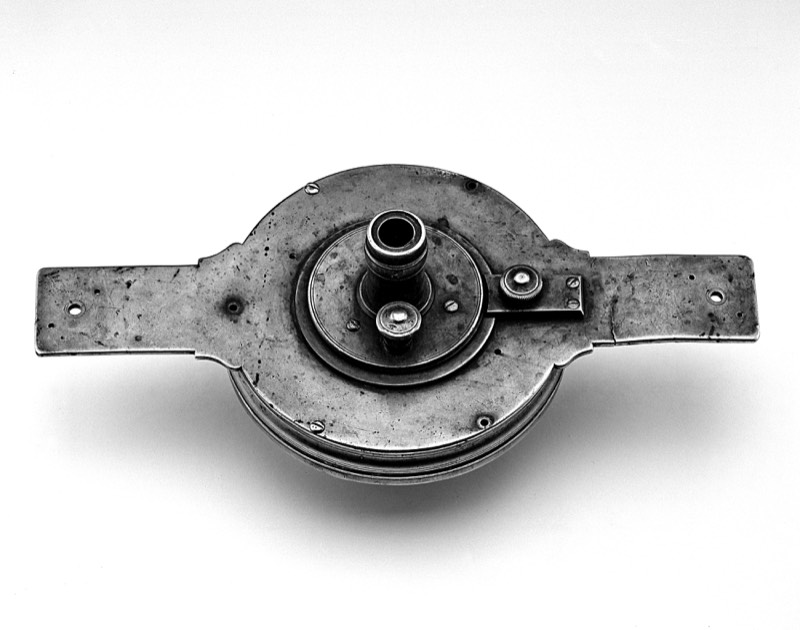
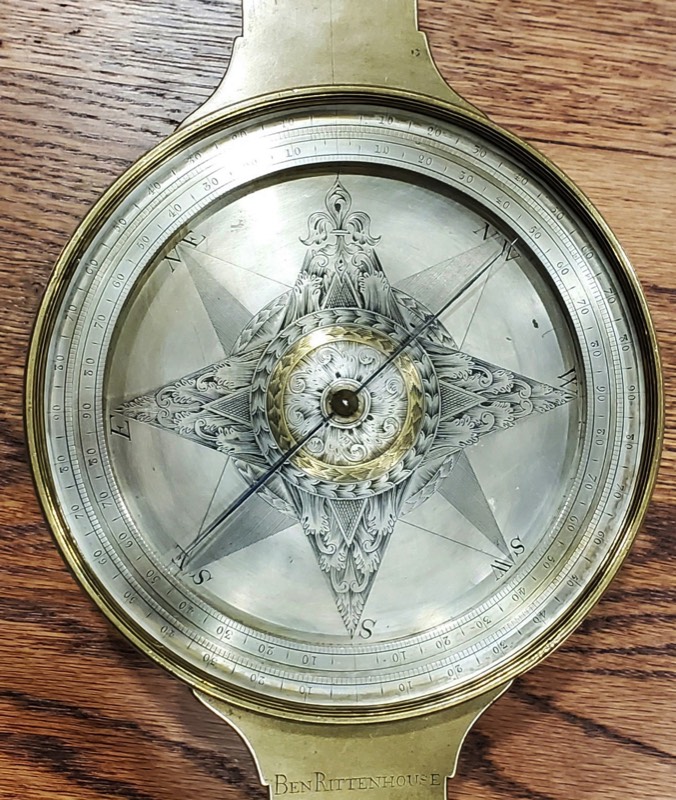

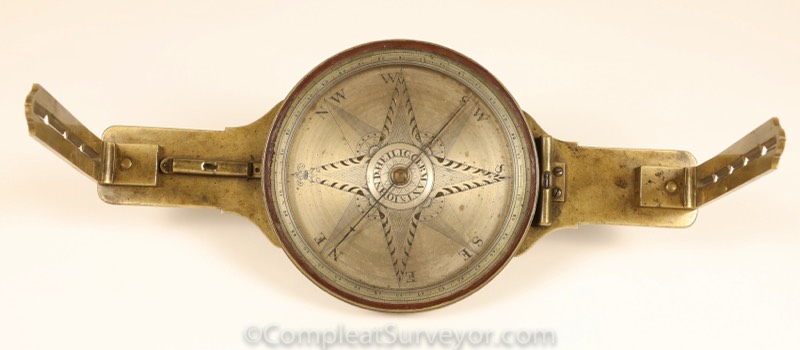
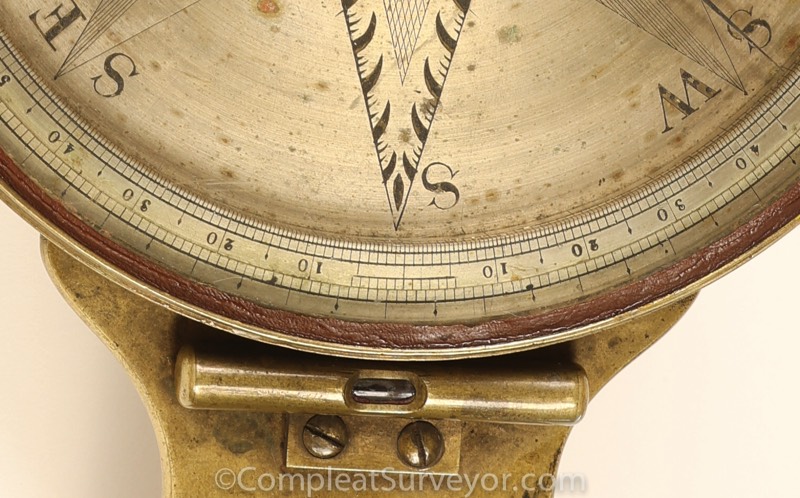
The last set of pics show a Heisely & Son Variation Compass Circa 1815. This compass has a very nicely done inner system that a surveyor could set to offset for variation (to degrees), but the compass doesn't really function like the Rittenhouse dividend needle ring compasses. The Heisely doesn't also have an actual Vernier scale that measured to minutes. Thus, while similar in approach to the first design of a Vernier Compass, the Heisely compass is a rather unique and eye catching variant.
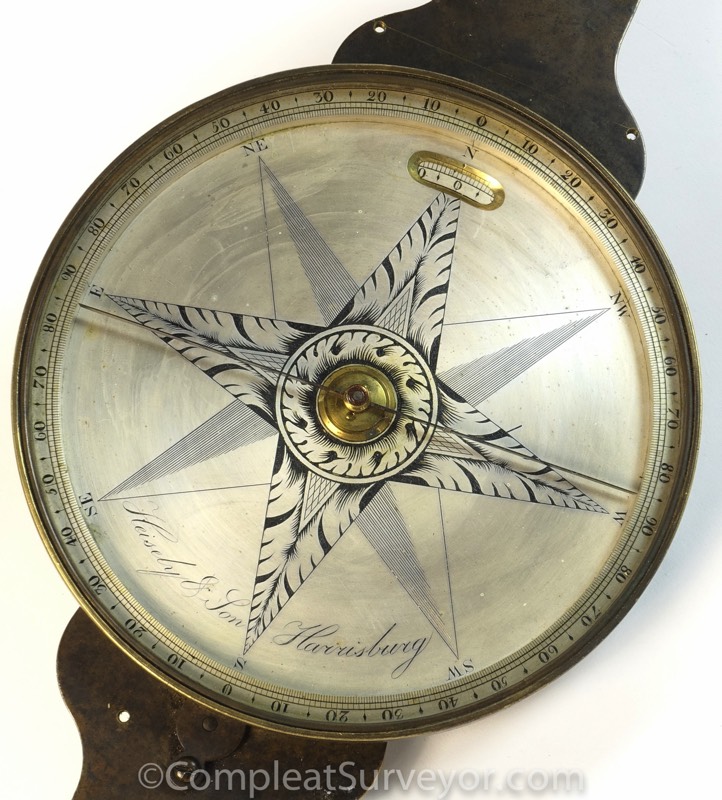
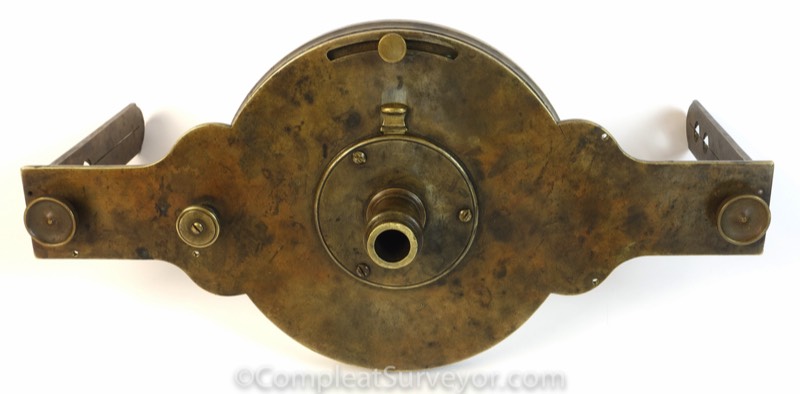
The First External Vernier Approach - Benjamin Rittenhouse & Lewis Michael
Likely with David's help, Benjamin Rittenhouse changed his vernier design from a split needle ring with an internal vernier scale to an external vernier design. Take a look at the two pics below showing the front and back of B Rittenhouse Compass. (This compass sold at Conestoga Auction Company Sale at $5500 (per LiveAuction) in 2017). This is the earliest external vernier compass I have seen - a very rare compass. Unfortunately the pics do not show what the vernier scale looked like.
Looking at the underside of the compass, it appears that the surveyor could rotate the compass box via a screw with internal gearing. There does not appear to be a way to lock the compass box into place.
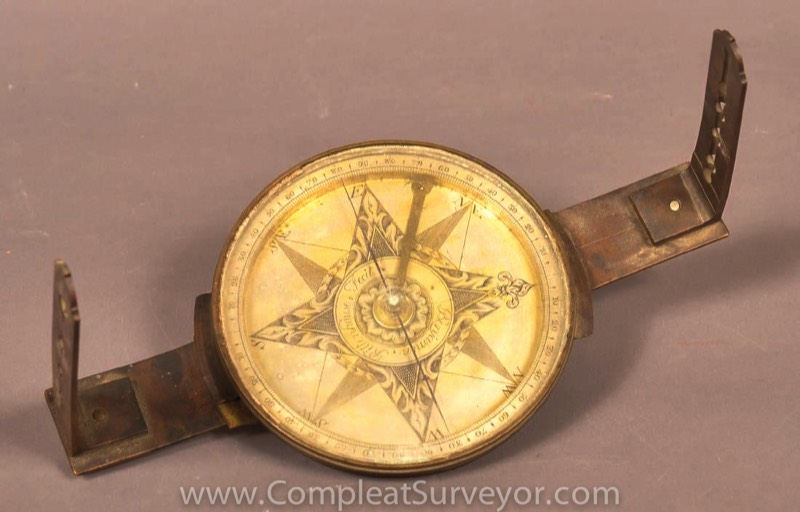
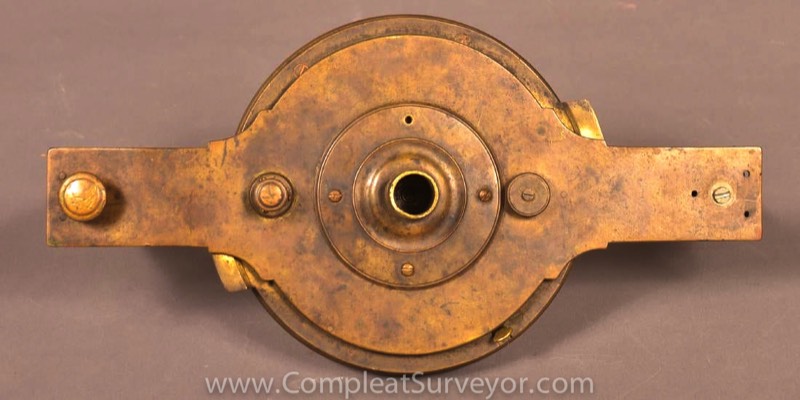
Lewis Michael apprenticed with the Rittenhouses prior to 1786 or so. See Bedini - Benjamin Rittenhouse and His Apprentices and Partners. So Michael fully understood how to make a Vernier Compass as a result of his time with the Rittenhouses. Interestingly, Michael's Vernier system differs significantly from the first design that David Rittenhouse came up with, and the split needle ring design that Benjamin introduced around 1785 or so (see above). The Lewis Michael Vernier Compasses look like they are based on the external vernier design that is reflected on the Benjamin Rittenhouse compass immediately above. One must therefore assume that Lewis Michael was still working for Benjamin when Benjamin made the above compass (likely in 1785 or 1786). Note that on the Lewis Michael Vernier Compass the surveyor would rotate the entire compass box by hand. There is no gearing or fine motion tangent screw to rotate the compass box. The Lewis Michael Vernier System is therefore rather crude and unrefined compared to the above Benjamin Rittenhouse Vernier Compass.
For the vernier scale, Lewis Michael used a "Folded Vernier" approach. The Folded Vernier approach featured two rows of numbers - going from right to left 30' - 15' - 60' - 15' - 30' on the bottom of the scale, and the top scale is empty of numbers but would be read as 45' - 60 - 45'. A "Folded Vernier" means you have two rows of minutes on the vernier scale. Simple enough to use once you get the hang of reading a vernier with a two row approach. And this design saved room - you didn't need as wide of a scale if you were able to fold your numbers like this. This vernier read to 5 minutes.
The Lewis Michael Vernier Compass can adjust for 10 degrees of variation, plus or minus.
All of the Lewis Michael Vernier Compasses I've seen have the exact same vernier system. He never evolved his vernier approach to a later design.
The first set of pics below show two different Lewis Michael Vernier Compasses. The compass on the left is Circa 1790s. The one on the right is Circa 1830. Same Vernier design. This design cannot function as a Minute Compass - you can't alter the Vernier setting without upsetting the compass.
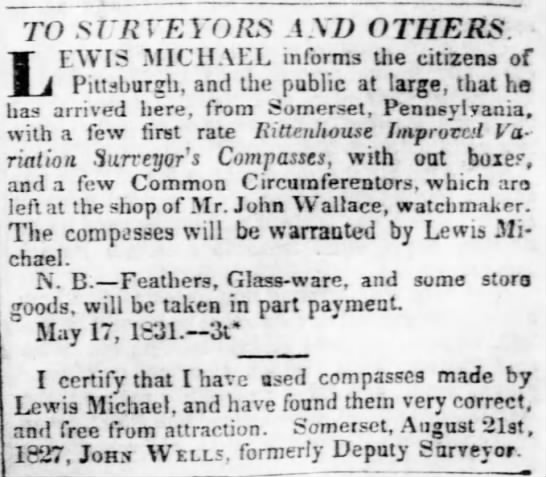
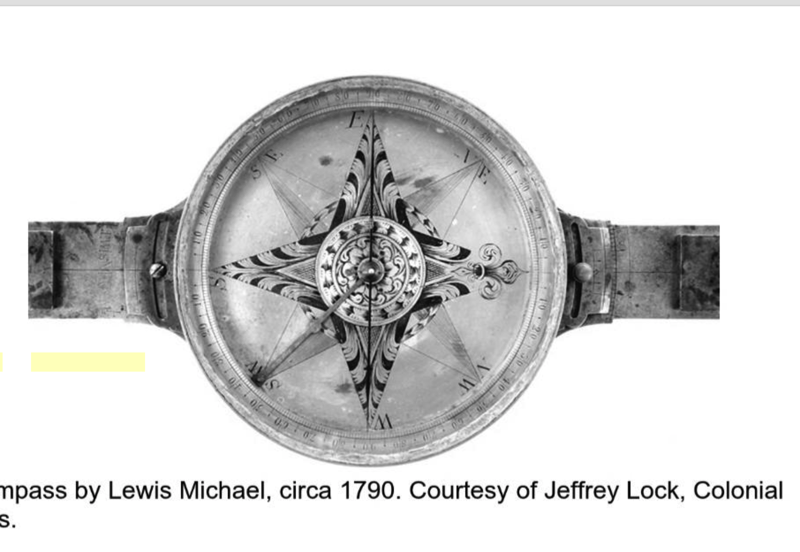
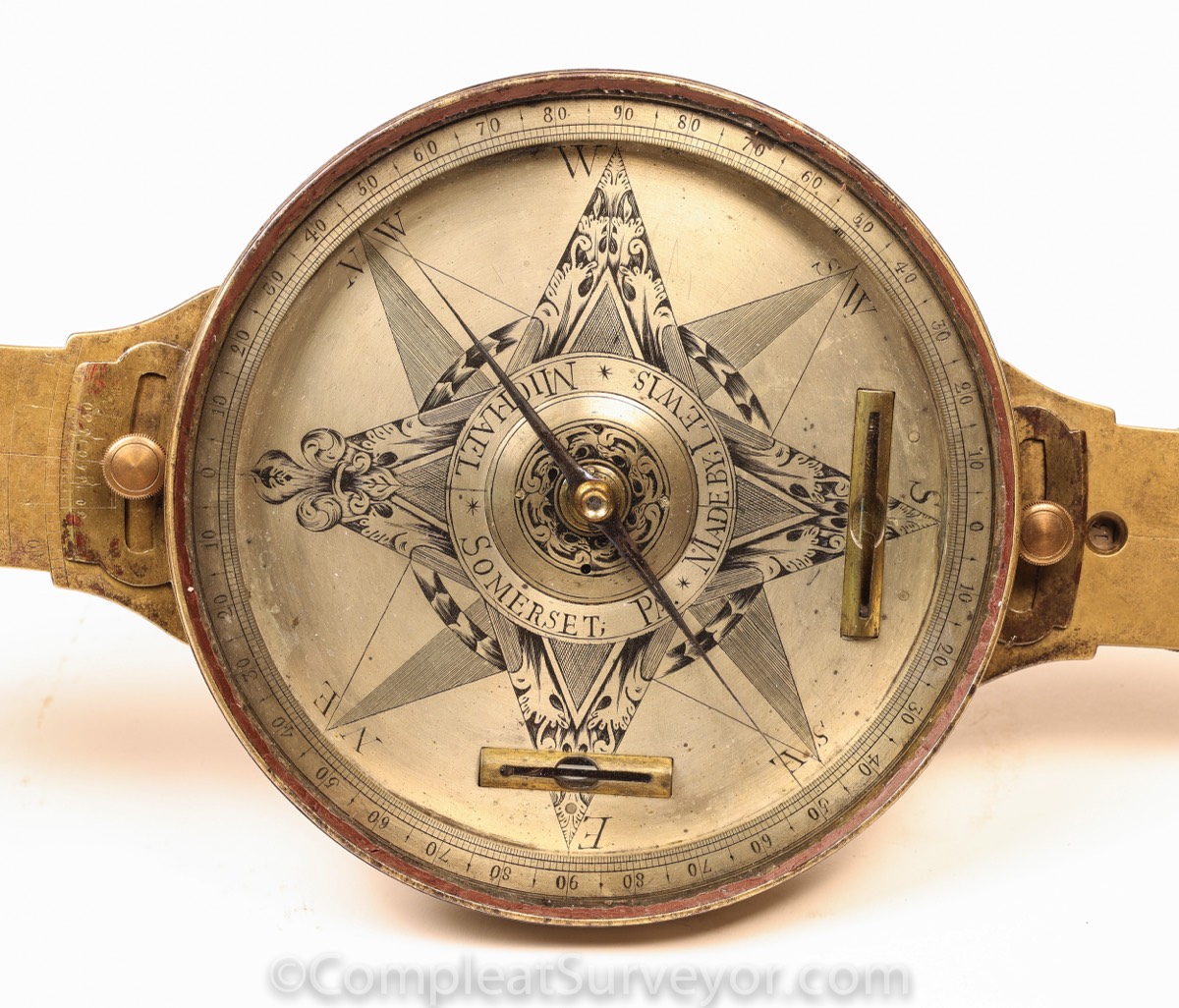
Below is a beautiful Issac Chandlee Vernier Compass dated 1801. Like the Lewis Michael Vernier Compass, this Chandlee has an external folded Vernier Scale and requires the surveyor to rotate the compass box by hand (there is no gearing or tangent screw to rotate the compass box). The Chandlee Vernier Compass can only adjust for 7 degrees of variation, plus or minus. The Chandlee also cannot function as a Minute Compass.

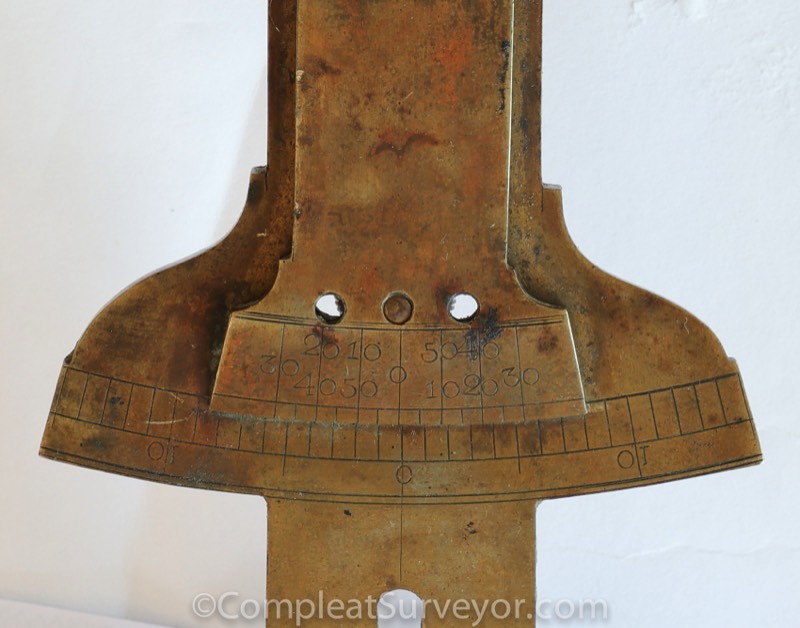
The External Vernier Approach Evolved - Expanded with Fine Motion & Folded Vernier - The Rittenhouses
Sometime in the late 1780s or early 1790s the Rittenhouses released the next Venier Compass design, and this won proved to be a winner. This Vernier Compass design had an expanded external vernier scale, a thumbscrew driven gear on the underside of the compass that rotated the compass box, and a thumbscrew that would lock the compass box into place. In the 1790s and early 1800s some commentators and textbook authors recommended using a Vernier Compass on the "Rittenhouse Design". This was the design they were likely referring too. The expanded vernier
For the vernier scale, this design used the "Folded Vernier" approach. Look at the first two rows of pics immediately below showing a Benjamin Rittenhouse Compass dated 1792. As the first pic on the left shows, the Folded Vernier approach featured two rows of numbers - plus or minus 15' and 30' on the bottom of the scale, and plus or minus 45' and 60' on the top of the scale. This vernier read to 5 minutes. I am told that the B Rittenhouse Vernier Compass shown below can only adjust for 9degrees of variation, plus or minus.
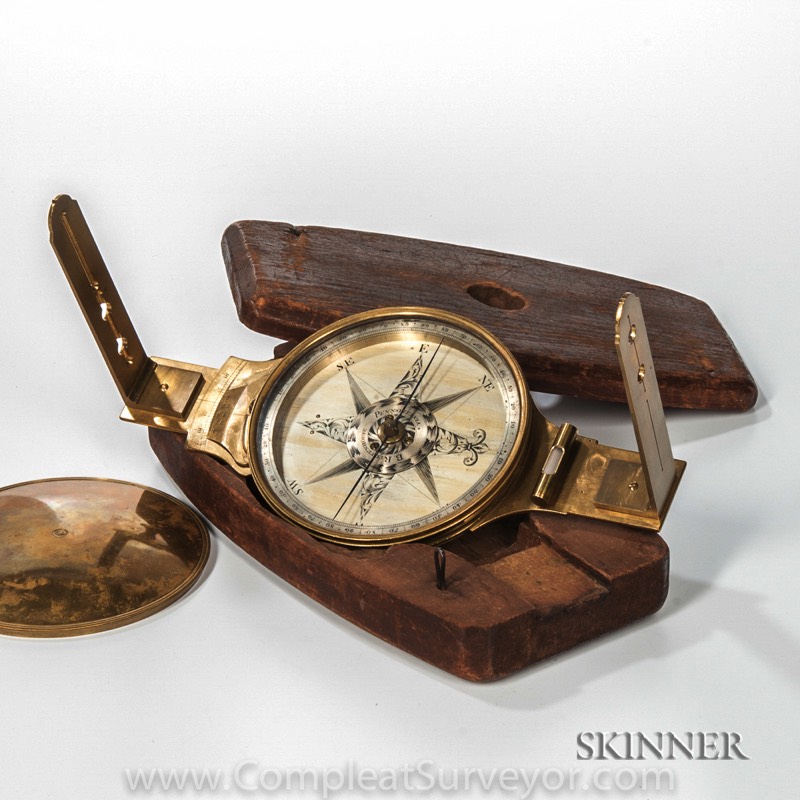
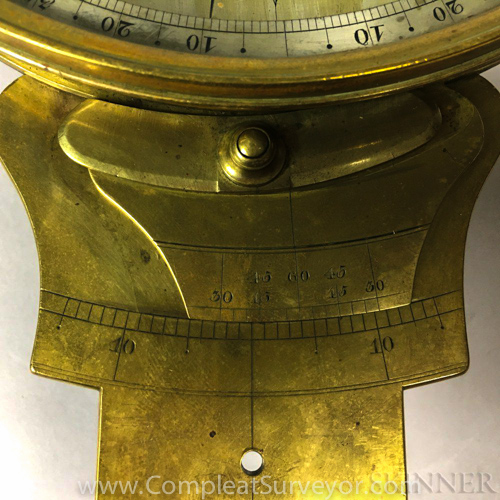

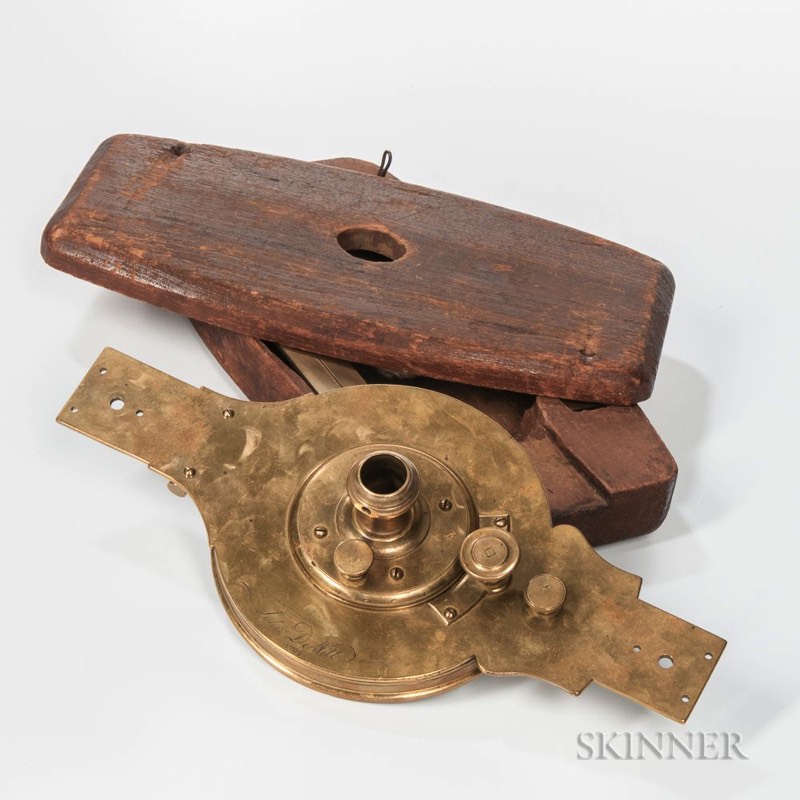


The Final Vernier Approach - Fine Motion & Full Vernier - Whitney
As the country opened up to the midwest and western U.S., the amount of Variation from the Magnetic North Pole to the True North Pole increased fairly dramatically. So the instrument makers had to keep increasing the size of the Vernier System to account for greatly increased Variation settings (up to 30 degrees). The base of compasses grew wider and wider as a result. This extra real estate allowed makers to go with a single row of minutes on the Vernier Scale (the makers "unfolded" the scale). This would be the main form of Vernier Scale going forward - extra wide to accommodate Variation setting of 30 degrees and under, with a vernier scale made up of a single row of minute settings. The designer would also have a thumbscrew driven gearing or a fine motion tangent screw to rotate the compass box.
Thomas Whitney was the first maker to use the extra wide Vernier system along with a single row of minutes on the vernier scale. Whitney's design became the de facto standard for compasses for over 100 years. Whitney put a lot of energy into education surveyors about the Variation of the Compass. He often pasted materials about Variation and how to measure it on the lid of his compass boxes. The pic immediately below shows what one of these educational peices looked like.
Most makers went to a fine motion tangent screw as reflected on the bottom row of pictures below (a Circa 1830s Meneely Compass is on the left while a Circa 1830s J Pool Compass is on the right). Note the top mounted tangent screws.
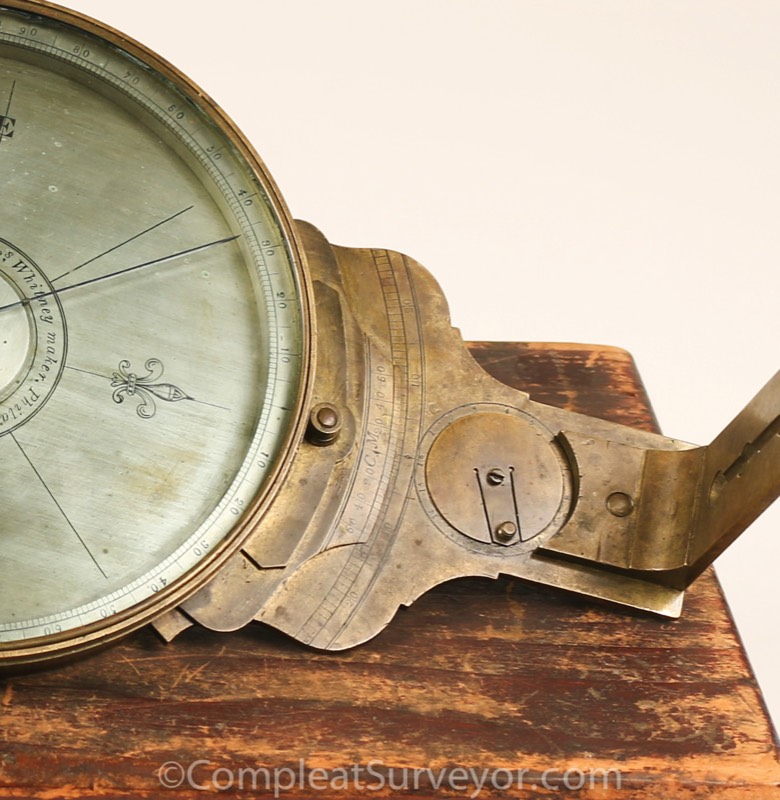
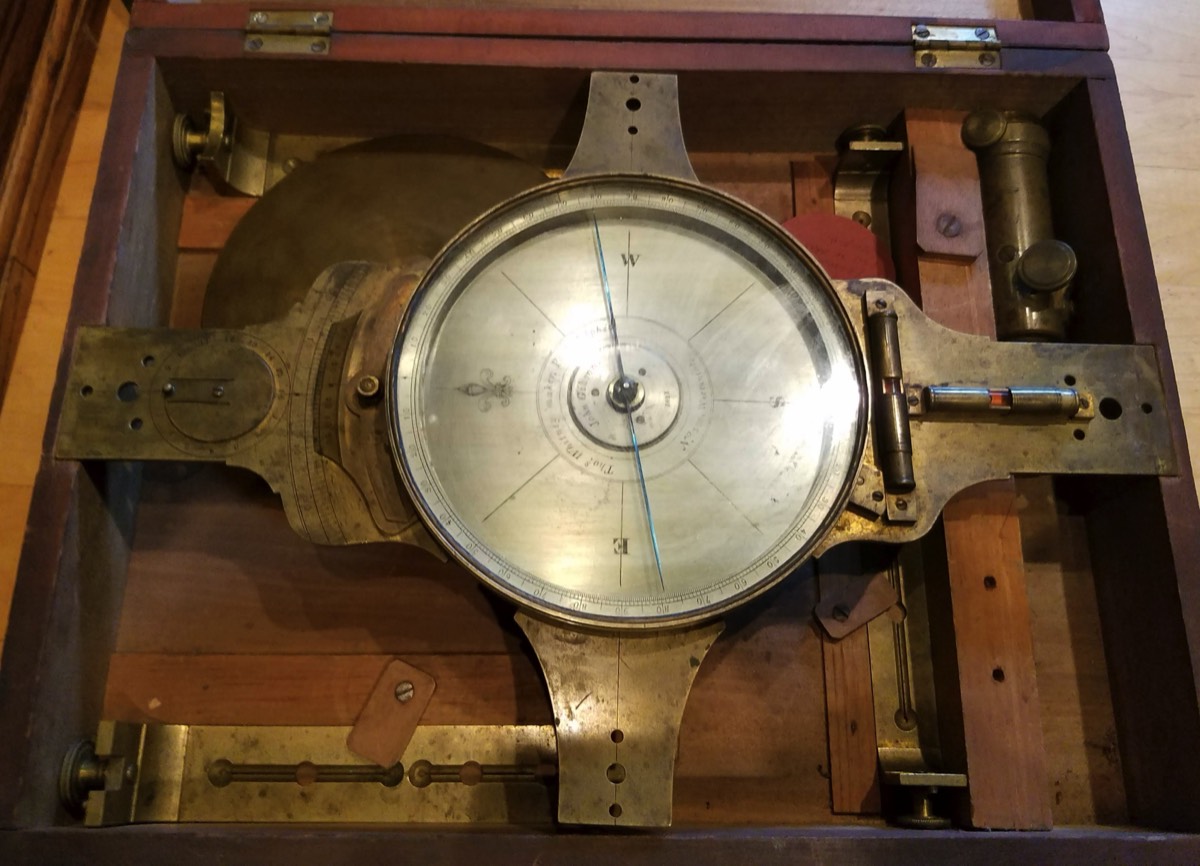
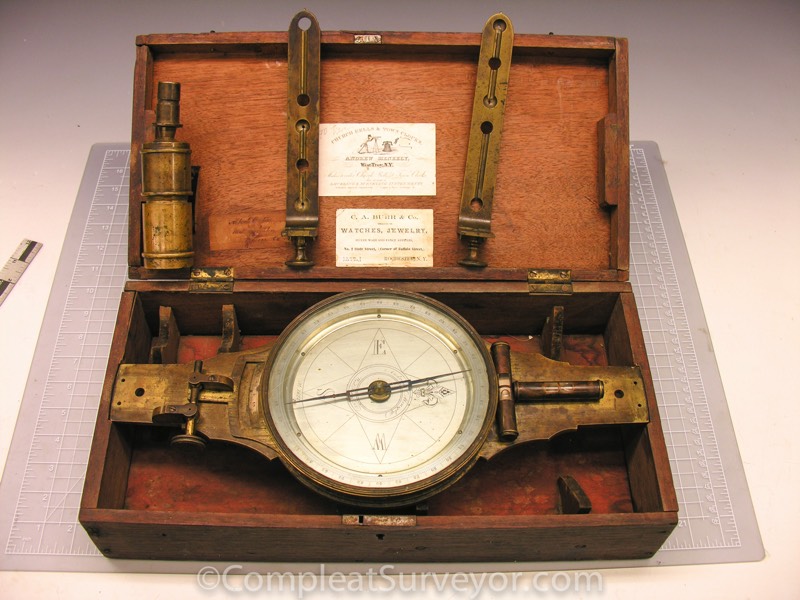

© 2020 Russ Uzes/Contact Me
